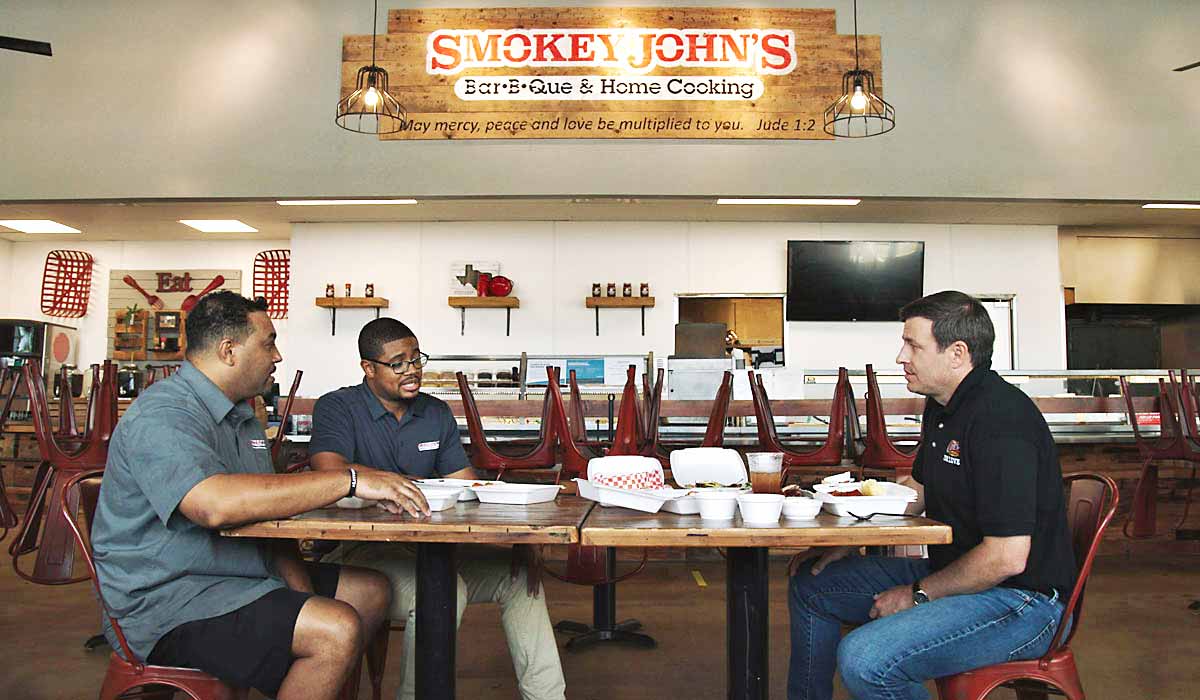Focus Brands wants digital and loyalty sales to mix 50 percent of the business within the next five years, a feat requiring full-fledged transformation of its online platforms.
CFO Mike Dixon notes the cost of building a website is close to $2 million, and that’s just to get the ball rolling. In subsequent years, brands typically spend nearly $500,000 to $1 million every year just to maintain it, which can pile up for a collection of seven mid-sized and smaller brands like Jamba, Moe’s, McAlister’s, Schlotzsky’s, Carvel, Cinnabon, and Auntie Anne’s.
The solution is a united front end—a single, best-in-class digital platform that can be replicated across all seven chains. That means creating an online presence with fewer steps during the ordering process and the ability to add messaging and functionality to the entire system at once.
“When you’re doing everything on a standalone basis, you’re not taking advantage of economies of scale,” Focus CEO Jim Holthouser says. “ … And instead of $1 million, we can give you a best-in-class website for about $250,000.”
It’s a far cry from where Focus was positioned when the CEO arrived two years ago. The chains were siloed and made decisions seven different ways—not wrong, but very expensive and inefficient, Holthouser says. The first step was reorganizing brands into specialty (Auntie Anne’s, Jamba, Cinnabon, Carvel) and restaurant (McAlister’s, Schlotzsky’s, Moe’s) categories, with specific leadership guiding each section.
READ MORE: Cinnabon, Carvel to Form Ultimate Sweet Treat Concept
For perspective of where things stand now, in February 2020, Focus’ restaurant brands saw digital mix 13 percent, but elevated to 28 percent by the end of 2021. For specialty chains, the channel grew from 4 to 7 percent. Company-wide, loyalty accounts for about 12 percent of sales.
The next major journey is building the unified online platform. Focus began experimenting earlier this year with Schlotzsky’s because it’s the least digital dependent, thus a smaller impact if something doesn’t go well.
Initially, roughly 95 percent of traffic went to the old app and website, while 5 percent was redirected to the newer version. Focus tracked click-through rates and looked at a heat map of where guests lingered. The pilot targeted new customers so the company could gain a blank-slate viewpoint.
As Focus becomes confident, more traffic will be diverted into the updated platform. All the lessons and headaches learned during this process will be used to help the next brand undergo the switch, which will be Moe’s, followed by McAlister’s and Jamba.
“This is a long-term journey,” Holthouser says. “It’s a good three to five years. The nice thing is you don’t have to wait three to five years to start unlocking value. … You’re just learning. You stand up teams and you’re solving problems. And sometimes you figure it out. Sometimes you don’t. If you don’t figure it out, you pivot and you go back.”
“It’s the same app, the same website,” he adds. “Just replicated with different window dressing by brand.”

“That’s where your opportunity is—to find those synergies and cost savings and add more fuel to the individual brands,” says Jim Holthouser, CEO of Focus Brands.
As part of this overall shift, Focus will fold in advanced suggestive selling. This includes personalized recommendations before and during the purchase, such as storing order history and taking customers deeper into the menu by suggesting items others have enjoyed.
Once products are in the shopping cart, there will be sophisticated upsells and add-ons to elevate what’s being bought. The pilot of this technology was launched this month.
“As we learn that customer, as we test and learn on different customer types, we’re starting to get into a place where we can get into really sophisticated suggestions,” says Claiborne Irby, SVP of strategy and insight at Focus. “Is it sweet or is it savory? How would that play out, and what’s the most likely outcome for someone to want to add that to their cart?”
“That’s the business side of it,” he adds. “But the customers will be walking away from this experience thinking, ‘Man, that was helpful.’ And they’re saying that oftentimes after spending more money than they might have otherwise.”
Focus is also planning AI-powered loyalty offers in lieu of wide-casting generic ones that are often expensive and less effective.
Irby gives the example of using a BOGO offer to lure different customers who haven’t been active for 45 days. In his hypothetical, the first individual only ever buys one entrée, so the offer is irrelevant. In another instance, the guest always adds a cookie or some other item to their order, so the deeply discounted BOGO offer is too rich. Then lastly, there’s another consumer who consistently visits every six to eight weeks, meaning the company didn’t need to send a BOGO offer to re-engage them.
READ MORE: Will Focus Brands Make the Next Big M&A Move?
The key is to calculate offers that work on an individual level. Irby says the customer who only buys one entrée may not go for the BOGO deal, but they may be interested in more loyalty points. As for the consumer that consistently visits every couple of months, all that’s needed is a call to action, which doesn’t cost more than an email.
“This transformation will take time,” Irby says. “It will feel weird, and it’s going to change how we do things, but it will be measurable, letting us know exactly what is and isn’t working.”
Long-term, these technological innovations will require tens of millions of dollars and investment in human capital, like new Chief Technology Officer Tim Voss, whose primary goal is to use technology to create more user-friendly programs and platforms.
Focus, with the backing of Roark Capital, will pay for upgrades upfront and with the help of a 35-cent transaction fee tacked on to digital orders. Holthouser adds that future growth of loyalty and transactions will pay back costs, too.
The CEO says there’s been much change in the past couple of years, and not without concern from operators. Some have worried about chains becoming homogenized, but Holthouser assures that’s not the case. Individual brand leadership is still in place to fundamentally protect what’s unique and special about each concept.
When running a multi-brand corporation, the executive has learned 5 percent of decisions should be brand specific, but everything else has nothing to do with differentiation.
“That’s where your opportunity is—to find those synergies and cost savings and add more fuel to the individual brands,” Holthouser says. “We’ve been through this over the last couple of years. We’ve started to take steps, and we’re pretty good at communicating with our owners. They’re not shy either. If there’s something wrong, they’re going to typically tell us. I don’t see that as an issue whatsoever right now.”









